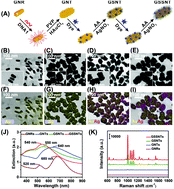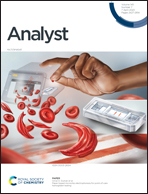Multiple and sensitive SERS detection of cancer-related exosomes based on gold–silver bimetallic nanotrepangs†
Abstract
Exosomes are endogenous vesicles of cells, and can be used as important biomarkers for cancers. In this work, we developed a sensitive and reliable SERS sensor for simultaneous detection of multiple cancer-related exosomes. The SERS detection probes were made of bimetallic SERS-active nanotags, gold–silver–silver core–shell–shell nanotrepangs (GSSNTs), which were composed of bumpy surface nanorod (gold nanotrepang, GNT) cores and bilayer silver shells, and decorated with linker DNAs, which were complementary to the aptamer targeting exosomes. Three kinds of SERS detection probes were designed via the adoption of different Raman reporter molecules and linker DNAs. The capture probes were prepared by modifying specific aptamers of the target exosomes on magnetic beads (MBs). In the absence of target exosomes, SERS detection probes were coupled with MBs via specific DNA hybridization for use as aptamer-based SERS sensors. In the presence of target exosomes, the aptamer specifically recognized and captured the exosomes, and GSSNTs were subsequently released into the supernatant. Therefore, attenuated SERS signals were detected on the MBs, indicating the presence of target exosomes. The proposed aptamer-based SERS sensor is expected to be a facile and sensitive method for the multiplex detection of cancer biomarkers and has potential future applications in clinical diagnosis.



 Please wait while we load your content...
Please wait while we load your content...